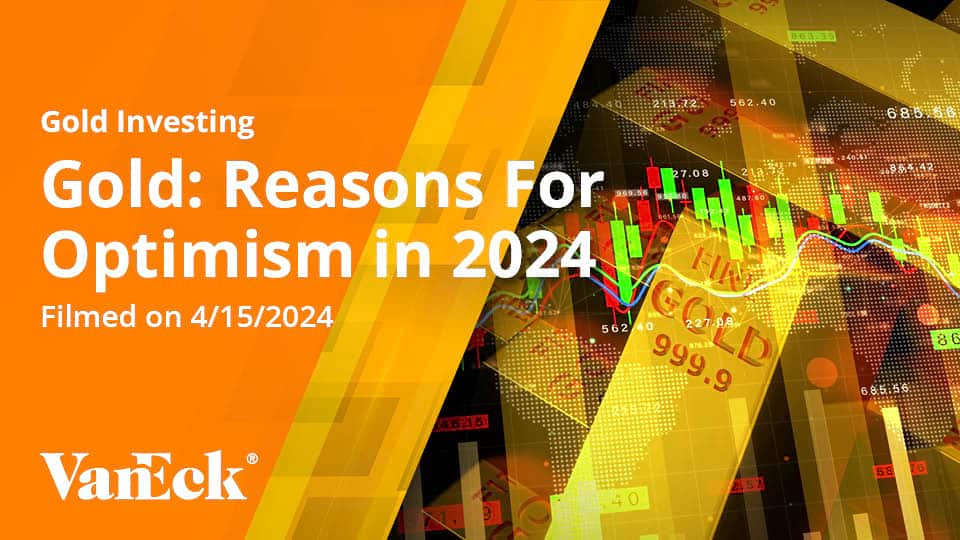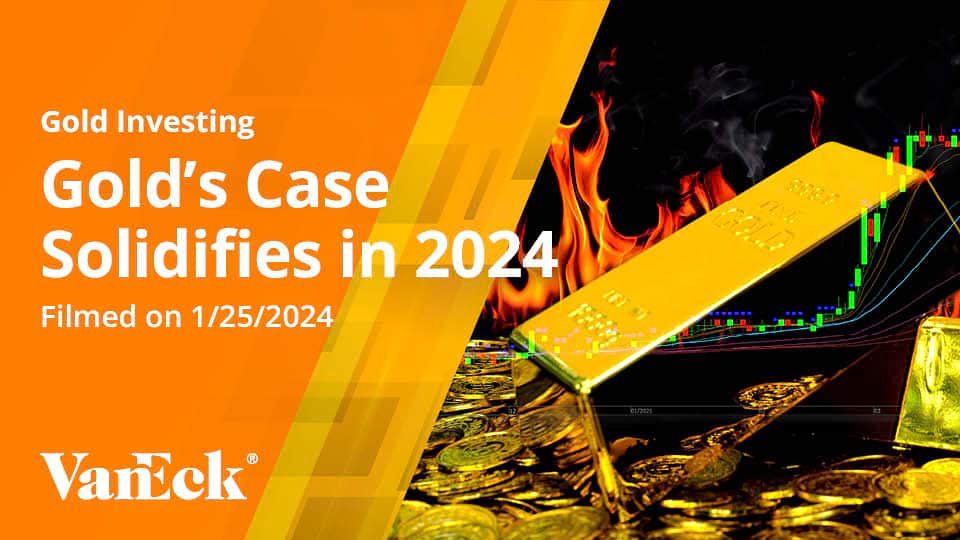Gold’s Allure Boosted by Rate, Inflation Outlook
09 February 2022
Read Time 6 MIN
If inflation remains elevated for several years, the financial system will not return to normal for an extended period, creating an environment where gold and gold stocks may shine.
Markets React to Rising Rates Expectations
Gold continued its year-long consolidation in a range centered roughly around $1,800 per ounce. U.S. interest rates, the U.S. dollar, and the U.S. Federal Reserve (the “Fed”) remain gold’s dominant drivers. Based on U.S. interest rate futures prices, on January 3 the market was anticipating the first Fed rate increase in May, with 77 basis points (bps) of tightening expected by year-end. Over the course of the month, markets priced in an increasingly hawkish Fed following the release of the minutes from the December Federal Open Market Committee (FOMC) meeting, Fed Chairman Powell’s congressional confirmation hearing, and the January FOMC policy meeting. As a result, expectations are now anticipating a March lift-off in U.S. rates and increases that would total at least 100 bps of tightening this year. This caused both interest rates and the U.S. dollar to trend higher, with 10-year U.S. treasuries making fresh two-year highs.
Gold Price’s Counter Moves Relatively Short-Lived
All of this is ostensibly negative for gold prices. However, the gold market trended to its high for the month of $1,853 on January 25 in choppy trading. Gold’s resilience didn’t last, when on January 26 Chairman Powell’s comments following the FOMC meeting caused the U.S. dollar index to break out to near-term highs and gold took a tumble—ending the month at $1,797.17 for a $32.03 (1.8%) loss. Gold stocks mimicked gold’s trend higher, then fell to end the month with losses of 5.7% for the NYSE Arca Gold Miners Index (GDMNTR)1 and 8.6% for the MVIS Global Junior Miners Index (MVGDXJTR).2
Gold Market Tides May Be Shifting
One of the defining characteristics of the lackluster gold market of the past year has been redemptions from gold bullion exchange traded products. The outflows indicate a lack of investment demand, particularly from institutional investors. However, on January 21, SPDR Gold Shares (GLD), the world’s largest gold ETF, recorded its biggest inflow ever in dollar terms, worth $1.63 billion. In tonnage terms it was the largest inflow since September 21, 2020. The deceleration in outflows shown on the chart suggests most of the selling pressure has passed, while the recent large inflow might mean that investment demand is picking up.
Inflation Finally Luring Investors Back to Gold?
Source: Bloomberg. Data as of February 2, 2022. Not a recommendation to buy or sell any security. Past performance is not indicative of future results.
More to Watch Beyond Gold Investment Demand
While bullion ETF investment demand has been lackluster, the World Gold Council’s (WGC) Gold Demand Trends report for 2021 shows every other source of gold demand has been gaining.
- Jewelry – Jewelry consumption grew 52% over 2020 to match the 2019 total. Indian demand nearly doubled in 2021 to a six-year high with a strong fourth quarter driven by pent-up demand in the festival seasons. Jewelry demand in the U.S. gained 26%, the strongest in 12 years. The WGC attributes this to a lack of competition for discretionary spending, given the ongoing lull in spending on travel and entertainment.
- Bars and Coins – Bar and coin demand had a 31% annual advance to an eight-year high. This was driven by China, the U.S., and Germany. China’s bar and coin demand increased 44% to a three year high. The U.S. and Germany both set new records. Bar and coin demand stands in stark contrast to the outflows in the bullion ETFs. Each is driven by different types of investors. Coin demand represents mainly retail investors, while bar demand reflects high-net worth investors. These investors are closer to “Main Street”, where inflation and pandemic-related risks are front and center. Bullion ETFs are dominated by institutional investors who are closer to “Wall Street”, where gold is weighed against myriad investment choices that have gained prominence.
- Industrial Manufacturing – Gold used in technology grew 9% to reach a three-year high. Electronics applications include LEDs, printed circuit boards, dynamic random-access memory (DRAM) chips, and wireless technology that includes automotive, satellites, 3D imaging sensors, and smartphones.
- Central Banks – Central bank demand increased 82%, lifting global reserves near a 30-year high. The largest buyers in 2021 were Thailand, India, Hungary, Brazil, Uzbekistan and Singapore. The trend to increase gold in foreign currency reserves is truly global.
Fed Easing Party’s Over…
Soon quantitative easing (QE) will be over and the Fed will begin raising rates. While Washington will always spend copious amounts of other people’s money, it looks like the multi-billion dollar stimulus packages are over, too. Through QE, the Fed has crowded out the private sector, funding over 50% of the entire government borrowing requirements since 2010. The Fed also holds over 30% of all federally insured mortgage-backed securities. All of this stimulus has distorted markets and the pricing signals they send to investors. For example, the yield curve has flattened at a time of increasing inflation expectations, which is the opposite of what happened in past inflationary cycles. The last time real rates were as deeply negative as in 2021 was 1974, a year when the S&P 500 Index (SPXTR)3 fell 37%. However, in 2021, the same stimulus-fueled index gained 29%.
Markets Might Need a Shoulder to Lean On
The realization of an economy without stimulus caused many major stock indices to decline in January. The New-Year’s volatility looks like a precursor to a year of extraordinary uncertainty as the financial system attempts to transition back to normal. The transition, if successful, will take years of 25 basis point rate changes and disposal of trillions in treasuries and mortgage-backed securities. We doubt the system can get back to normal without more and possibly extreme market volatility along with some unintended consequences.
So far, gold has sidestepped the market’s volatility. Its January performance was boring, just hanging around $1,800 as it has done for over a year now. In such a market, perhaps boring is good. However, we expect to see more from gold in 2022. We expect it to outperform as the risks around a tightening Fed play out and as other inflation drivers continue to mount.
No Shortage of Supply Shortages
The Wall Street Journal reports port congestion is expanding to the East Coast while the queue of vessels waiting to enter southern California ports reached a record in January. U.S. firms’ semiconductor chip inventory has declined further to less than five days. McDonald’s Corp. said it expects the rate of cost increases for food, paper and other materials in the U.S. to roughly double this year. Also, most foreign business investment is not going into increasing production. The United Nations Conference on Trade and Development showed the number of new projects to expand capacity falling in 2021 to remain far below their 2019 level. Foreign investment is being used to purchase existing business, rather than greenfields projects that expand manufacturing.
Pandemic’s History Lesson: Inflation
The last pandemic that was comparable in terms of lethality broke out over a century ago and was accompanied by World War I, but it’s arguably the only pandemic we have for comparison. The spending on the war can probably be roughly equated to the spending to fight the coronavirus pandemic. Inflation surged to 18% in 1918, 14.6% in 1919, and 15.6% in 1920. While we don’t expect double digit inflation in this post-pandemic cycle, if inflation simply remains elevated for several years, the financial system will not be able to return to normal for an extended period. This could be shaping up to be an environment where gold and gold stocks are able to shine.
Related Insights
IMPORTANT DEFINITIONS & DISCLOSURES
This material may only be used outside of the United States.
This is not an offer to buy or sell, or a recommendation of any offer to buy or sell any of the securities mentioned herein. Fund holdings will vary. For a complete list of holdings in VanEck Mutual Funds and VanEck ETFs, please visit our website at www.vaneck.com.
The information presented does not involve the rendering of personalized investment, financial, legal, or tax advice. Certain statements contained herein may constitute projections, forecasts and other forward looking statements, which do not reflect actual results. Information provided by third-party sources are believed to be reliable and have not been independently verified for accuracy or completeness and cannot be guaranteed. Any opinions, projections, forecasts, and forward-looking statements presented herein are valid as of the date of this communication and are subject to change without notice. The information herein represents the opinion of the author(s), but not necessarily those of VanEck.
The views contained herein are not to be taken as advice or a recommendation to buy or sell any investment in any jurisdiction, nor is it a commitment from Van Eck Associates Corporation or its subsidiaries to participate in any transactions in any companies mentioned herein. This content is published in the United States. Investors are subject to securities and tax regulations within their applicable jurisdictions that are not addressed herein.
All investing is subject to risk, including the possible loss of the money you invest. As with any investment strategy, there is no guarantee that investment objectives will be met and investors may lose money. Diversification does not ensure a profit or protect against a loss in a declining market. Past performance is no guarantee of future results.
IMPORTANT DEFINITIONS & DISCLOSURES
This material may only be used outside of the United States.
This is not an offer to buy or sell, or a recommendation of any offer to buy or sell any of the securities mentioned herein. Fund holdings will vary. For a complete list of holdings in VanEck Mutual Funds and VanEck Vectors ETFs, please visit our website at www.vaneck.com.
The information presented does not involve the rendering of personalized investment, financial, legal, or tax advice. Certain statements contained herein may constitute projections, forecasts and other forward looking statements, which do not reflect actual results. Information provided by third-party sources are believed to be reliable and have not been independently verified for accuracy or completeness and cannot be guaranteed. Any opinions, projections, forecasts, and forward-looking statements presented herein are valid as of the date of this communication and are subject to change without notice. The information herein represents the opinion of the author(s), but not necessarily those of VanEck.
The views contained herein are not to be taken as advice or a recommendation to buy or sell any investment in any jurisdiction, nor is it a commitment from Van Eck Associates Corporation or its subsidiaries to participate in any transactions in any companies mentioned herein. This content is published in the United States. Investors are subject to securities and tax regulations within their applicable jurisdictions that are not addressed herein.
All investing is subject to risk, including the possible loss of the money you invest. As with any investment strategy, there is no guarantee that investment objectives will be met and investors may lose money. Diversification does not ensure a profit or protect against a loss in a declining market. Past performance is no guarantee of future results.

